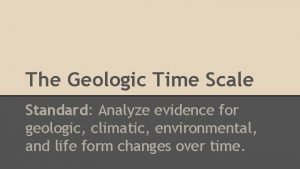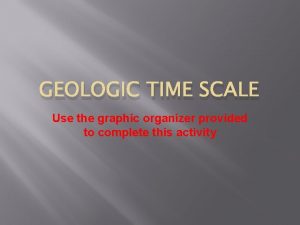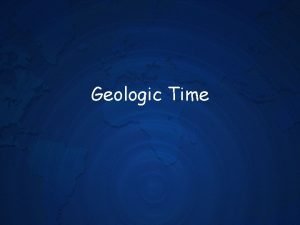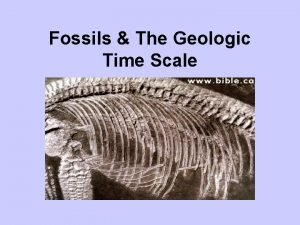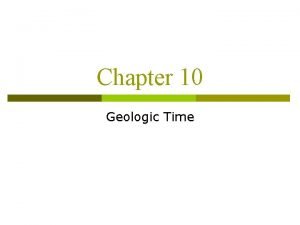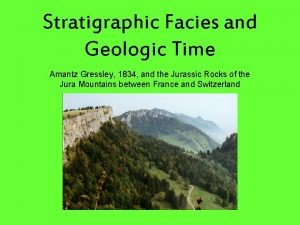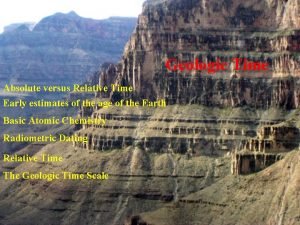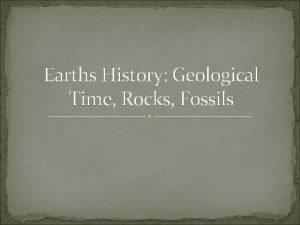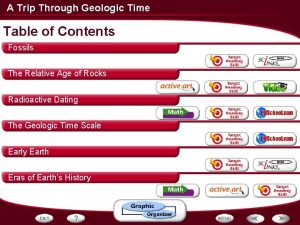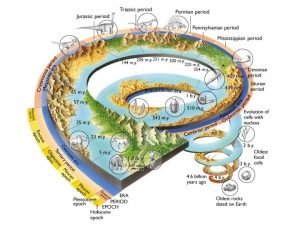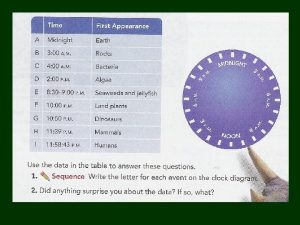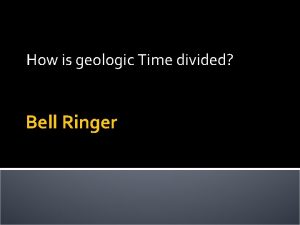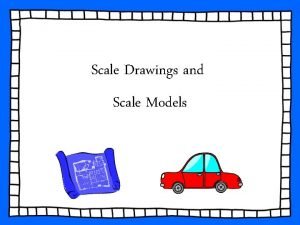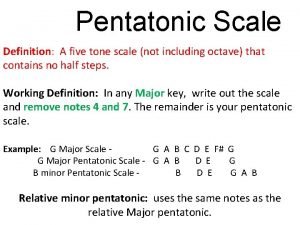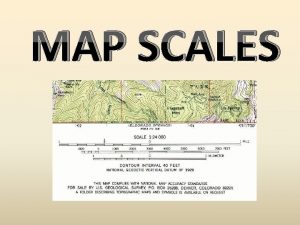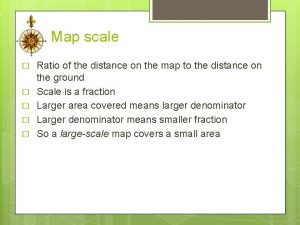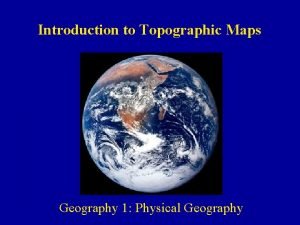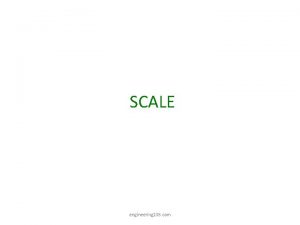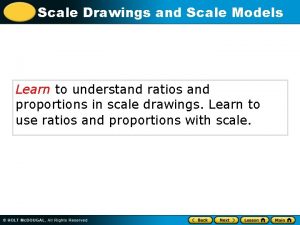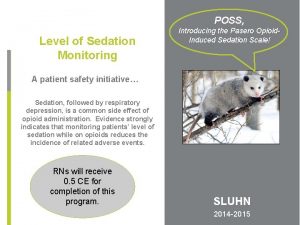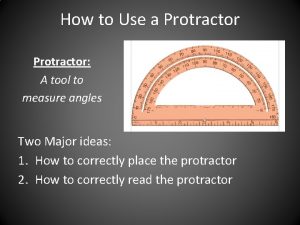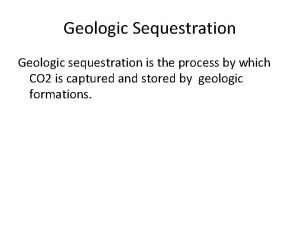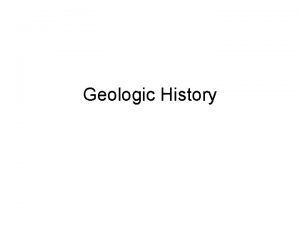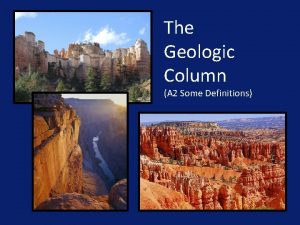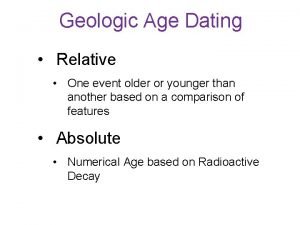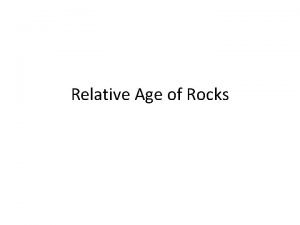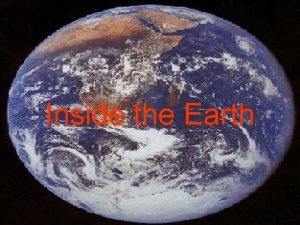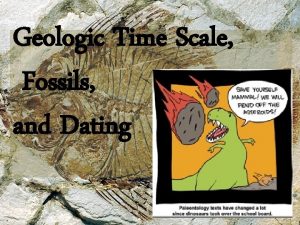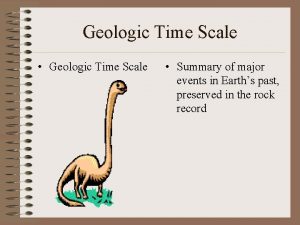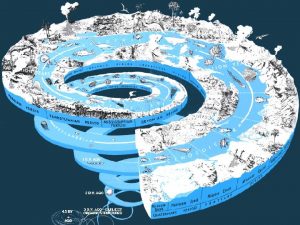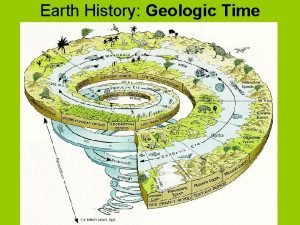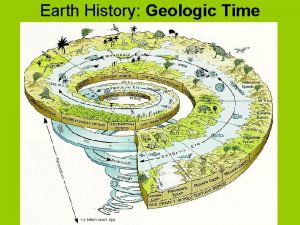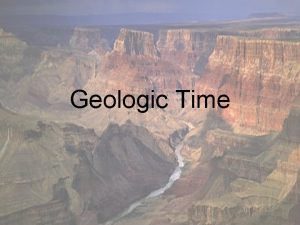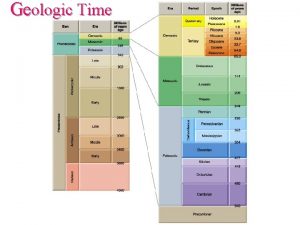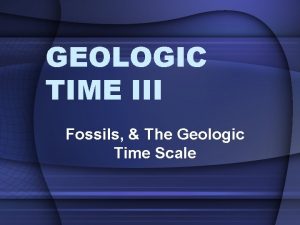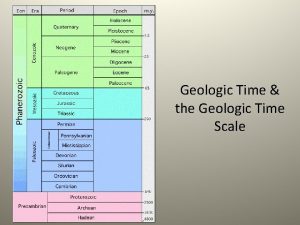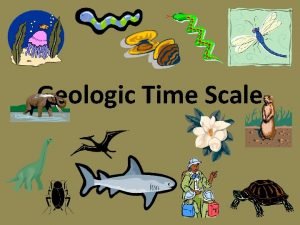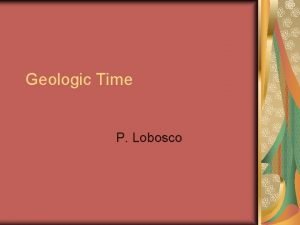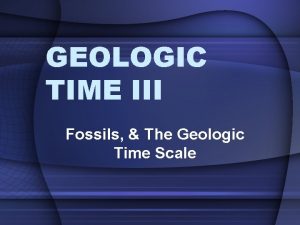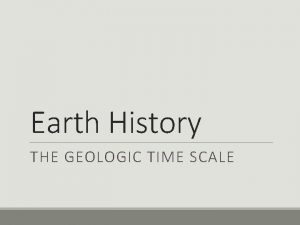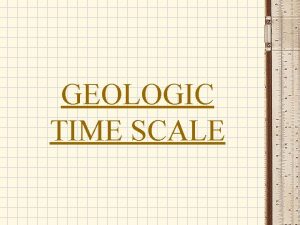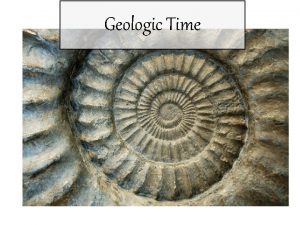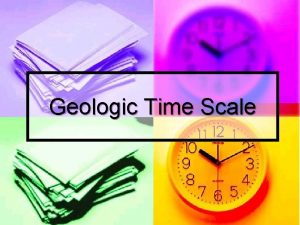Geologic Time The geologic time scale Dating Methods















































































- Slides: 79

Geologic Time The geologic time scale, Dating Methods, & Order of Events

A Brief history of the Earth… Earth formed from collisions of meteors= colossal planet of accreted material Estimated 20 million yrs to cool from creational collisions Earth has never completely cooled. . . why? Heat is still produced by radioactive decay of materials inside of the earth (Uranium, thorium and potassium)

Early Atmosphere Formed as a result from out-gassing of water vapor (H 20), Carbon Dioxide (CO 2), and Nitrogen (N) from cooling crust and earth’s interior Early Ocean Formed as result of precipitation over millions of years after clouds were created from CO 2 + H 2 O Was rich in iron=green oceans Is indicated by the earliest formed sedimentary rocks dating back to 4 billion yrs old!

Evolution of the Atmosphere It wasn’t until the evolution of stromatolites (bacterial algae) that our atmosphere had enough O 2 to support life Took in large amounts of CO 2 through photosynthesis Pre-cambrian rock with thick hematite bands (Iron oxide precipitate) This extra O 2 reacted with iron in seas/crust turning to rust. We had a red planet!

Ozone Layer Formation of Ozone (O 3) in atm. now blocked out UV radiation This is what allowed ancient life (insects, amphibians and reptiles) to evolve on land

How has geologic history been reconstructed? The key is FOSSILS (composition, & content) Evidence from rocks dates back 4. 2 billion years (compared t 0 the 4. 6 billion known age of earth) Geologist separate earth’s history into divisions based upon the Fossil Record

What do these divisions look like? Divisions are in order of ↓ length of time Eons (billions of yrs) ↓ Era (100’s of millions billions yrs) ↓ Periods (10’s-100’s million yrs) ↓ Epoch (millions-10’s mill yrs)

Geologic History: page 8 & 9 ESRT

“Ceno”=recent “Meso”= Middle “Paleo”= old *Precambrian Time is divided into Protozoic & Archaen EONs & makes up 90% of all geologic history

Methods of Dating: Rock and Fossils!

“Relative Time: ” Ages of events are placed in order of occurrence in relation to other events No exact date is identified. Ex. WWI and WWII I was born first

Finding age with relative time: 1. The Law of Superposition - in a sequence of undisturbed sedimentary rocks, the oldest rocks will be at the bottom.

Vs. Absolute Time A specific time Ex: the Dinosaurs went extinct in 65 M. A. *Is not exact (has a margin of error) but absolute dating techniques are usually very accurate (to be con’t…)

There are 4 principles to follow with relative dating of rocks/fossils 1. ) Law of Superposition 2. ) Law of Inclusions 3. )Law of Cross-Cutting Relationships 4. ) Law of Folding

3. The law of inclusions - the fragments that make up a rock are older than the entire sample.

2. The law of cross-cutting : – anything that “cuts across” layers of rock is younger than the rocks that it has intruded into. Ex: Faults and Igneous Intrusions

*Exception to the rule= Igneous Extrusions We know that rocks continually form in horizontal layers so… Rule: An extrusion is younger than any rocks beneath it but will be older than any rocks that form on top of it

Which came first; faulting or the igneous intrusion?

Igneous Intrusion (white)

#1 -Dike(Lateral Igneous Intrusion) with #2 - Faulting

4. The Law of Folding: tilts in rocks are younger than the rocks themselves. 4. BECAUSE OF : PRINCIPLE OF Original Horizontality. Rocks are usually deposited flat and level.

Other Guidelines for figuring out a sequence: Uplift, followed by erosion will cause rock layers to become partially removed or completely removed This will form an “Unconformity. . ” Submergence: or Land subsidence= Land sinking. Sed. Rocks are formed Under Water!

Unconformity This means that there is missing information in the rock record Usually is evidence of buried eroded surfaces Process: Uplift exposed rocks to surface weathering + erosion area covered by water again deposition of new rock layers = unconformity (geologic gap)

#1 Tilting and Unconformity #2 due to uplift erosion followed by deposition of new sediments

Folding with Unconformity

Sequence 1: Uplift & Erosion 1. 2. 3. 4. 5. Limestone deposited Sandstone deposited Shale Deposited Uplift Erosion

Sequence 2: Faulting 1. Limestone deposited 2. Sandstone deposited 3. Shale deposited 4. Faulting

Sequence 3: Folding 1. Limestone deposited 2. Sandstone deposited 3. Shale deposited 4. Folding

Sequence 4: Igneous Intrusion 1. Limestone deposited 2. Sandstone deposited 3. Shale deposited 4. Igneous Intrusion Note: contact metamorphism is the same event as the intrusion.

What does the unconformity (buried erosional surface) at line XY represent? 1. an area of contact metamorphism 2. a time gap in the rock record of the area 3. proof that no deposition occurred between the Cambrian and Carboniferous rock layers 4. overturning of the Cambrian and Carboniferous rock layers

Lab: Order of Events/Relative Dating Processes: Uplift/Emergence (EM), Erosion (E), Deposition of rocks (Dep), Submergence (SU), Faulting, Folding, Igneous Intrusions…




Correlation (Matching) Correlation is using rocks (or geologic events) from different regions to show they are relatively the same age Used when there are index fossils Used when there are similarities in rock features/types (mineral composition, overall appearance or same sequence)

Correlation with index fossils

Index Fossils An Index Fossil is a special fossil good for relative dating *Traits*: Easily Recognized, wide-spread geographically, & abundant (lots of them found) Each existed for a short period of time Used by: geologists to match rock sequences (layers) They can be dated using your chart Each is assigned a letter Find the letter on the chart to estimate an age


Once the absolute age of the rock is known which holds an index fossil, any area in the world with that same fossil can be estimated to be the same relative age

Correlation using the same rock sequences (order of layering) - These limestone layers must have formed at the same relative time!

Correlation with Volcanic Ash has unique composition and serves as a good age marker in sequences

Why does correlation work? Similar sequences (order of layering) of rock layers & the fossils within them can be found very far away from one another Based upon the law of original horizontality and superposition and properties of index fossils we can “match” rock layers an infer a relative geologic age (Remember, rock sequences will never exactly be the same due to erosion, folding, faulting and igneous intrusions/extrusions)

Each group can have 5 minutes with each core Examine, conclude and replicate In your column include: 1. ) layer # from top bottom 2. ) rock name 3. ) fossils found

Time for an activity! We will be using a total of 4“drill cores” to draw stratigraphic columns (1 for each) We will then use the method of correlation (matching fossils and rock types) to make a correlation chart of each core (cut and paste!) At the end you will be asked to use your chart in order to organize the fossils from youngest oldest

Absolute Time: identifies the exact date of an event . Ex. The dinosaurs became extinct 65 Million Years Ago I was born in 1986

Q: But how do we find Absolute Time? Using the RADIOACTIVE DECAY RATE of elements Elements exist in several varieties these varieties are called Isotopes For example: Carbon-12 (most common) and Carbon-14 The # of the isotope comes from the mass of the atoms

Half Life The time required for half of the atoms in a given isotope to decay Each radioactive isotope has its own characteristic half-life NOT changed by: T, P, mass or quantity of the sample has been the same throughout all of Earth’s History (never changes/always same length of time)

Q: Why wouldn’t using C-14 for dating the extinction of the Dinosaurs work?

You can find Radioactive Decay data on the front of your ESRT

Radioactive Dating Radioactive dating is using the known half-life of an isotope and comparing it to the ratio between the parent: daughter isotopes to find the absolute age Example: A rock only has grains of Ur-238, as time passes, the UR-238 will decay to Pb-206 Its half life= 4. 5 billion years If it has a ratio of 1: 1 it means it has = parts of Ur and Pb so it must have formed 4. 5 billion yrs ago If that same rock had a ratio higher than 1: 1 than it must have formed less than 4. 5 billion yrs ago (ex: 2: 1)

Common Isotopes used C-14: Has a shorter half life= 5, 700 yrs Called “Radio-Carbon” dating Used to date rocks and bones up to 70, 000 yrs old Uranium 238 is used to date the oldest rocks (millions billions years old) because it has the longest half life (4. 5 billion years)

How can you identify the half life of C-14 using a graph?

The steeper the curve, the shorter the half life (because more is decaying faster)

A problem together… Q: What is the mass of original C-14 remaining (grams) after 34, 200 years?

More Problems A fern fossil that originally contained 50 (g) of C-14 now only contains 12. 5(g) of C-14. Approximately how many years ago was this fern part of the living environment? Step 1: What is the half life of C-14? 5, 700 years Step 2: Make a chart of Mass remaining Vs. Time from start to finish Mass Remaining 50 grams 25 grams _____ Time 0 5, 700 _____

An igneous rock contains 6 (g) of K-40 and 54 grams of Ar-40 How old is the rock? Step 1: half life of K-40? ________ Create a chart: mass remaining vs. time *If you have 6 g of K-40 and 54 of Ar-40 they must add up to the original amount of the parent= 60 g Mass Remaining K-40 60 30 15 6. 25 3. 1 Time 0 1. 3 billion 2. 6 billion 3. 9 billion 5. 2 billion

A Brief overview of decoding geologic history using the ESRT…












Q 1: Does NYS have a better record of the Cretacious or Devonian period? Q 2: Which two periods are completely missing from the rock record in NYS?

YOU GOT THAT!?

Good…because we’re not done


Q: How many years ago did the dinosaurs go extinct? (Where does the line end? )

Q: Between what years did Trilobites Exist? -The first Trilobites came around 520 m. a. (bottom of line) -The last of them went extinct 251 m. a. (top of line)



Time for some problems…

Geology of NYS pg 3 ESRT

Sample Regents Q: What is the geologic age of the surface bedrock of most of the Allegheny Plateau landscape region in NYS? Cambrian Devonian Silurian Ordovician
 Compare geologic time with the geologic column.
Compare geologic time with the geologic column. Contemporary dating patterns are formal patterns
Contemporary dating patterns are formal patterns How is the geologic time scale organized
How is the geologic time scale organized My geologic time scale graphic organizer
My geologic time scale graphic organizer Geologic time scale in a calendar year
Geologic time scale in a calendar year Geologic time scale animals
Geologic time scale animals Geologic time scale drawing
Geologic time scale drawing Moth scale
Moth scale Nooa
Nooa Facies
Facies Silurian period
Silurian period Geologic time scale
Geologic time scale Geologic time scale drawing
Geologic time scale drawing Brainpop geologic time
Brainpop geologic time Geological time scale graphic organizer
Geological time scale graphic organizer Eon division
Eon division Time scale
Time scale What is the longest subdivision in geologic time
What is the longest subdivision in geologic time Chapter 12 geologic time
Chapter 12 geologic time Direct wax pattern
Direct wax pattern Linear geography
Linear geography How to identify scale factor in scale drawings
How to identify scale factor in scale drawings The ________ scale is also known as the five-tone scale.
The ________ scale is also known as the five-tone scale. What is a map scale
What is a map scale Scale of a map
Scale of a map Large scale vs small scale map
Large scale vs small scale map Large scale vs small scale map
Large scale vs small scale map Scale up scale out
Scale up scale out Scale up and scale out in hadoop
Scale up and scale out in hadoop Scale drawings/models & scale factor
Scale drawings/models & scale factor Plain scale can measure upto
Plain scale can measure upto A proportional, two-dimensional drawing of an object
A proportional, two-dimensional drawing of an object Pasero opioid induced sedation scale
Pasero opioid induced sedation scale Datascale systems
Datascale systems Inner scale protractor
Inner scale protractor Inner and outer scale of protractor
Inner and outer scale of protractor What is representative fraction
What is representative fraction Caprock
Caprock Geologic history
Geologic history Geologic column definition
Geologic column definition Pilot knob volcano
Pilot knob volcano Principle of superposition
Principle of superposition Geologic history
Geologic history Marli miller
Marli miller What is earth made out of
What is earth made out of California geologic energy management division
California geologic energy management division Hát kết hợp bộ gõ cơ thể
Hát kết hợp bộ gõ cơ thể Ng-html
Ng-html Bổ thể
Bổ thể Tỉ lệ cơ thể trẻ em
Tỉ lệ cơ thể trẻ em Gấu đi như thế nào
Gấu đi như thế nào Tư thế worm breton là gì
Tư thế worm breton là gì Chúa yêu trần thế
Chúa yêu trần thế Môn thể thao bắt đầu bằng chữ đua
Môn thể thao bắt đầu bằng chữ đua Thế nào là hệ số cao nhất
Thế nào là hệ số cao nhất Các châu lục và đại dương trên thế giới
Các châu lục và đại dương trên thế giới Công thức tiính động năng
Công thức tiính động năng Trời xanh đây là của chúng ta thể thơ
Trời xanh đây là của chúng ta thể thơ Cách giải mật thư tọa độ
Cách giải mật thư tọa độ 101012 bằng
101012 bằng Phản ứng thế ankan
Phản ứng thế ankan Các châu lục và đại dương trên thế giới
Các châu lục và đại dương trên thế giới Thơ thất ngôn tứ tuyệt đường luật
Thơ thất ngôn tứ tuyệt đường luật Quá trình desamine hóa có thể tạo ra
Quá trình desamine hóa có thể tạo ra Một số thể thơ truyền thống
Một số thể thơ truyền thống Cái miệng nó xinh thế chỉ nói điều hay thôi
Cái miệng nó xinh thế chỉ nói điều hay thôi Vẽ hình chiếu vuông góc của vật thể sau
Vẽ hình chiếu vuông góc của vật thể sau Biện pháp chống mỏi cơ
Biện pháp chống mỏi cơ đặc điểm cơ thể của người tối cổ
đặc điểm cơ thể của người tối cổ V. c c
V. c c Vẽ hình chiếu đứng bằng cạnh của vật thể
Vẽ hình chiếu đứng bằng cạnh của vật thể Vẽ hình chiếu vuông góc của vật thể sau
Vẽ hình chiếu vuông góc của vật thể sau Thẻ vin
Thẻ vin đại từ thay thế
đại từ thay thế điện thế nghỉ
điện thế nghỉ Tư thế ngồi viết
Tư thế ngồi viết Diễn thế sinh thái là
Diễn thế sinh thái là Dot
Dot Số nguyên là gì
Số nguyên là gì Tư thế ngồi viết
Tư thế ngồi viết


